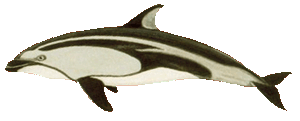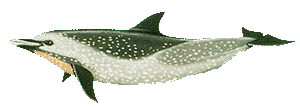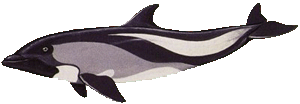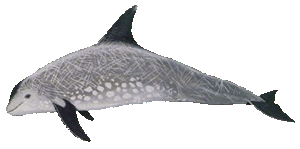|
|
|
|
|
Back to the main menu of species Northern Right-Whale Dolphin 
Scientific Name: Lissodelphis borealis Other Names: Pacific Rightwhale Porpoise Length: 6.5-9.8 ft. (2-3 m.) Weight: approx. 130-220 lbs. (60-100 kg.) Teeth: 150-200 Right-whale dolphins have slender beaks
and no dorsal fins. The upper surface of their bodies are black, but there is a
large white patch on the belly between the flippers and a long narrow streak of
white extending from this to the flukes. The white in the southern form is more
extensive than the northern form. The lower jaw of the northern right whale
dolphin extends beyond the tip of the upper jaw.
Pacific White-Sided Dolphin 
Scientific Name: Lagenorhynchus obliquidens Other Names: White-striped Dolphin Length: 5.8-8 ft. (1.7-2.4 m.) Weight: 185-330 lbs. (85-150 kg.) Teeth: 84-130 Pacific White-Sided dolphins often associate
with other cetaceans. They are active and demonstrative animals. These dolphins
have been seen leaping clear out of the water, cavorting, and almost anything
else to make a splash. Pacific White-Sided dolphins have a soft, subtle color
pattern. The patterns vary greatly between individuals. They also resemble dusky
dolphins.
Pantropical Spotted Dolphin 
Scientific Name: Stenella attenuata Other Names: White-spotted dolphin, Bridled dolphin, Slender beaked dolphin Length: 5.8-7.5 ft. (1.7-2 m.) Weight: 200-255 lbs. (90-115 kg.) Teeth: 140-190 Pantropical spotted dolphins vary greatly in
shape, size, and color. There are currently two major forms of this dolphin. One
lives in coastal waters and the other in offshore waters. The offshore form is usually
less robust, smaller, and has less spots. Not all spotted dolphins have spots. Newborn
pantropical spotted dolphins are born without spots and gain their spots as they
reach maturity. There are also some populations that do not possess spots, even in
adulthood. Pantropical spotted dolphins are very active animals. They swim quickly,
lobtail, bowride, and frequently breach. These dolphins often associate with whitefin
tuna, therefore, many fishermen seek out these dolphins to catch the tuna.
Unfortunately, in many cases, these dolphins are also caught in the nets with the tuna.
Peale's Dolphin 
Scientific Name: Lagenorhynchus australis Other Names: Blackchin Dolphin, Southern Dolphin Length: 6.5-7.3 ft. (2-2.4 m.) Weight: approx. 255 lbs. (115 kg.) Teeth: 108-132 This species inhabits remote areas of the
southern hemisphere. Observation of this species is very hard, therefore,
we have little information about them. There are only about twenty
specimens known. They have been seen in the company of risso's dolphins.
There are concerns about peale's dolphins being caught in fish nets
and being hunted with harpoons for use as crab bait.
Pygmy Killer Whale 
Sceintific Name: Feresa attenuata Other Names: Slender Pilot Whale Length: 7-8.5 ft. (2.1-2.6 m.) Weight: approx. 240-375 lbs. (110-170 kg.) Teeth: 36-50 The dorsal fin is high and the flippers are
long and thin. There is little know about the Pygmy Killer Whale and it is rarely
seen in the wild. This species is known to avoid boats, however, there have
been reports of them bow-riding, wake-riding, logging, spyhopping, lobtailing,
and breaching. Pods usually swim abreast and when alarmed, they bunch
together and swim away. They are also known to be aggressive in captivity.
Risso's Dolphin 
Scientific Name: Grampus griseus Other Names: White-head Grampus, Grampus, Grey Dolphin Length: 8.5-12.5 ft. (1.3-1.7 m.) Weight: 660-1,100 lbs. (300-500 kg.) Teeth: 4-14 This species has achieved modest fame
through the exploits of 'Pelorus Jack', a Risso's dolphin that used to escort
ships crossing Cook Strait between the two main islands of New Zealand
between 1888 and 1912. He/she would meet nearly every ship between the
two islands and escort them for several miles, riding the bow waves and/or
cavorting along side. In recognition of this, the New Zealand legislature
granted Pelorus Jack full governmental protection.
Please dont forget to sign my guestbook as I love getting mail.Sign my Dreambook! |